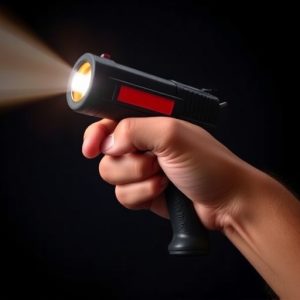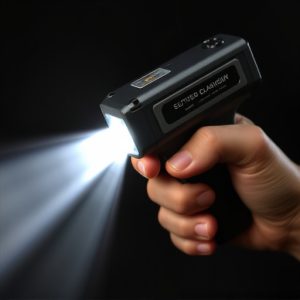Civilian Taser Laws: State Requirements, Eligibility, and Use Cases
Stun guns (Tasers) are non-lethal electroshock weapons that temporarily disable targets with high-vo…….
Stun guns (Tasers) are non-lethal electroshock weapons that temporarily disable targets with high-voltage, low-current electric pulses. US state laws vary widely regarding civilian ownership and usage, focusing on public safety and categorized by voltage, current output, and carry regulations. Legal acquisition typically requires background checks, training, permits or licenses, age restrictions, and proof of self-defense need. Understanding how stun guns work—delivering shocks through prongs to temporarily paralyze targets—is crucial for responsible ownership. Future laws may expand accessibility with safety measures like mandatory training, while technological advancements could lead to more user-friendly designs.
“In an era where personal safety is a paramount concern, understanding civilian taser ownership requirements becomes essential. This comprehensive guide delves into the world of stun guns, exploring their simple yet effective operation—how they disable targets through electrical impulsing muscle contractions. We navigate state laws regulating taser ownership, highlighting eligibility criteria for citizens aiming to acquire these devices. Furthermore, we examine legal implications and practical use cases while anticipating future trends in this evolving landscape.”
- Understanding Stun Guns: A Simple Explanation of How They Work
- Overview of State Laws Regulating Civilian Taser Ownership
- Eligibility Criteria for Acquiring a Taser as a Citizen
- Legal Implications and Use Cases for Owning a Taser
- Future Trends and Considerations in Taser Ownership Laws
Understanding Stun Guns: A Simple Explanation of How They Work
Stun guns, also known as Tasers, are electroshock weapons that use electrical current to temporarily disable a target. They operate by firing two small probes connected to thin wires, which make contact with the subject and deliver a powerful electric pulse. This sudden jolt disrupts muscle control, causing the individual to experience intense pain, disorientation, and temporary paralysis. The effect is designed to subdue an assailant without causing serious physical harm, allowing users to gain control and escape potentially dangerous situations.
The technology behind stun guns has evolved significantly since their inception, with modern Tasers offering increased range, accuracy, and safety features. They operate on a battery-powered system, utilizing high-voltage, low-current electrical energy to immobilize targets while leaving permanent marks on the skin at the point of contact. This unique approach ensures that stun guns are classified as non-lethal weapons, making them legal for civilian use in many states with specific guidelines and restrictions in place.
Overview of State Laws Regulating Civilian Taser Ownership
In the United States, state laws govern the ownership and usage of stun guns or tasers by civilians, providing varying levels of regulation based on public safety concerns. These laws cover aspects such as age restrictions, permit requirements, and allowed uses. Understanding these regulations is crucial for anyone considering owning a stun gun to ensure compliance with local statutes.
The operation of a stun gun, also known as how a stun gun works, involves delivering an electric current through two probe tips connected to the device, temporarily incapacitating a target by disrupting muscle control. State laws often categorize stun guns based on their voltage and current output, with some states permitting only low-voltage devices for personal protection while others allow higher-powered models. Additionally, these regulations may specify if a stun gun can be carried openly or concealed and under what circumstances its use is justified, such as in self-defense scenarios.
Eligibility Criteria for Acquiring a Taser as a Citizen
In many states, civilians can legally own a taser for self-defense purposes, but there are stringent eligibility criteria that must be met. Potential buyers typically need to pass a background check and demonstrate proficiency in the safe handling of the device. Some jurisdictions also require individuals to complete a training course on the use of stun guns, known as electroshock weapons or tasers, before acquiring one. This training ensures citizens understand how these devices work—by delivering an electric shock that temporarily disables a target—and emphasizes responsible usage.
The eligibility process often involves obtaining permits or licenses, with specific requirements varying by state. These may include proof of age (typically 21 or older), successful completion of a safety course, and demonstrating a valid need for self-defense. Law enforcement agencies or authorized dealers usually facilitate these processes, ensuring only qualified individuals gain access to stun guns, thereby promoting public safety.
Legal Implications and Use Cases for Owning a Taser
Owning a taser, also known as a stun gun, comes with legal implications and specific use cases that vary by state. While some states allow qualified individuals to carry stun guns for self-defense, others have stringent requirements regarding permits, training, and registration. Understanding how these devices work is crucial before considering ownership. A stun gun delivers an electric current through two prongs or probes, temporarily disrupting muscle control in the target, causing them to fall to the ground. This non-lethal force can be a powerful tool for self-defense, as it allows users to incapacitate assailants without causing permanent harm.
Use cases for taser ownership include personal protection, especially in high-crime areas or for individuals who feel vulnerable in their daily lives. Some states permit the use of stun guns in situations where force is necessary to protect oneself or others, making them a viable option for those seeking non-lethal means of self-defense. However, it’s essential to follow local laws and regulations regarding storage, transport, and use to avoid legal repercussions.
Future Trends and Considerations in Taser Ownership Laws
As technology advances, so do concerns regarding civilian access to stun guns or Tasers. Future trends in taser ownership laws may involve more stringent regulations or, conversely, broader accessibility depending on regional contexts and public perception. One potential direction is increased focus on safety measures, including mandatory training programs for users and clear guidelines on permissible use scenarios. This shift could ensure that individuals who choose to own a stun gun understand the device’s functionality—how does a stun gun work?—and its limitations.
Additionally, advancements in taser technology might lead to more compact, user-friendly designs, making them more appealing to civilians for self-defense purposes. However, these developments must be accompanied by legal frameworks that address potential misuse and ensure equitable access. The ongoing dialogue between law enforcement agencies, policymakers, and the public will shape these future trends, aiming to balance personal safety with responsible ownership.
In conclusion, understanding the intricacies of state laws regarding civilian taser ownership is paramount. As discussed, these regulations vary widely across jurisdictions, with requirements focusing on eligibility criteria, legal implications, and responsible use. Armed with knowledge about how stun guns operate and the evolving trends in ownership laws, citizens can make informed decisions while navigating the legal landscape. Remember that staying within the bounds of the law ensures the safe and appropriate use of tasers, contributing to public safety and security.


